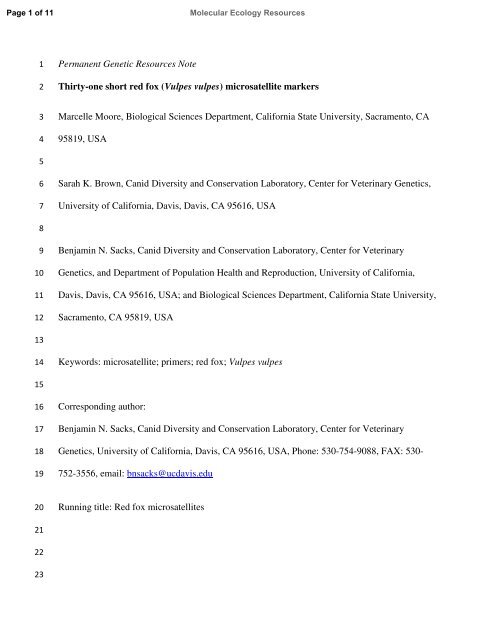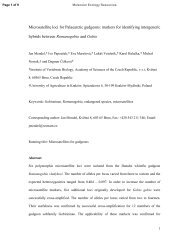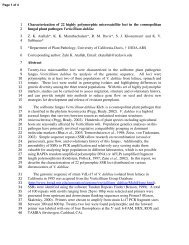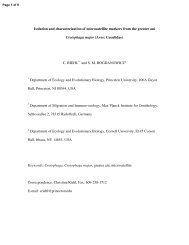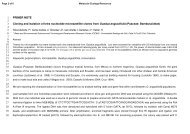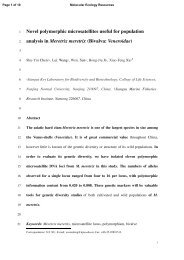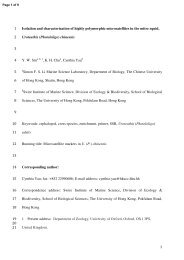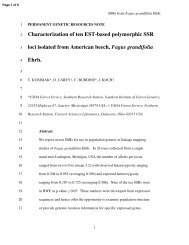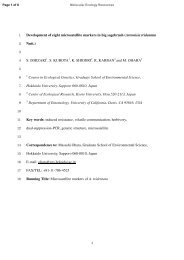Permanent Genetic Resources Note Thirty-one short red fox (Vulpes ...
Permanent Genetic Resources Note Thirty-one short red fox (Vulpes ...
Permanent Genetic Resources Note Thirty-one short red fox (Vulpes ...
You also want an ePaper? Increase the reach of your titles
YUMPU automatically turns print PDFs into web optimized ePapers that Google loves.
Page 1 of 11Molecular Ecology <strong>Resources</strong>12<strong>Permanent</strong> <strong>Genetic</strong> <strong>Resources</strong> <strong>Note</strong><strong>Thirty</strong>-<strong>one</strong> <strong>short</strong> <strong>red</strong> <strong>fox</strong> (<strong>Vulpes</strong> vulpes) microsatellite markers34Marcelle Moore, Biological Sciences Department, California State University, Sacramento, CA95819, USA567Sarah K. Brown, Canid Diversity and Conservation Laboratory, Center for Veterinary <strong>Genetic</strong>s,University of California, Davis, Davis, CA 95616, USA89101112Benjamin N. Sacks, Canid Diversity and Conservation Laboratory, Center for Veterinary<strong>Genetic</strong>s, and Department of Population Health and Reproduction, University of California,Davis, Davis, CA 95616, USA; and Biological Sciences Department, California State University,Sacramento, CA 95819, USA1314Keywords: microsatellite; primers; <strong>red</strong> <strong>fox</strong>; <strong>Vulpes</strong> vulpes1516171819Corresponding author:Benjamin N. Sacks, Canid Diversity and Conservation Laboratory, Center for Veterinary<strong>Genetic</strong>s, University of California, Davis, CA 95616, USA, Ph<strong>one</strong>: 530-754-9088, FAX: 530-752-3556, email: bnsacks@ucdavis.edu20Running title: Red <strong>fox</strong> microsatellites212223
Page 3 of 11Molecular Ecology <strong>Resources</strong>46474849505152535455565758596061626364656667We first designed external sequencing primers from dog flanking sequences around 37published dog microsatellite loci and <strong>one</strong> sex marker, a portion of the canine amelogenin genewith homologues of differing length on X and Y chromosomes (Supplemental Information Table1). We used the University of California Santa Cruz Genome Browser (http://genome.ucsc.edu;Karolchik et al. 2003) and PRIMER3 software (http://frodo.wi.mit.edu/primer3/) for thispurpose.Next, we used these external primers to amplify and sequence 4 <strong>red</strong> <strong>fox</strong>es at each locus.To insure that subsequently designed internal primers (i.e., genotyping primers) would beconserved across the species, we chose individuals from distant locations within the species’range (Sweden, Idaho, California Sacramento Valley, and California nonnative). We extractedDNA from blood or muscle tissue using the Qiagen DNeasy tissue kit (Qiagen, Hilden,Germany). We PCR amplified fragments in 23 µl reactions containing primers (0.2 µM), 30-100ng DNA, dNTPs (0.2mM), 1x Abgene PCR buffer IV, MgCl 2 (2.8 mM), 1.7 µg BSA, and 1 UAbgene Taq polymerase. The thermal profile consisted of 94 o C for 10 min, 85 o C for 10 min(during which taq and buffer mix was added for a hot start), 16 cycles of 94 o C for 1 min, 64 o C to48 o C touchdown for 30 sec, 72 o C for 30 sec., followed by 20 cycles of 94 o C for 1 min, 48 o C for30 sec., 72 o C for 30 sec., and a final extension for 4 min at 72 o C. Products were purified usingMillipore’s Multiscreen PCR u96 filter kit and sequenced in both the forward and reversedirections using BigDye Terminator v3.1 (Applied Biosystems, Foster City, CA) reagents andprotocols. Sequencing products were purified using Millipore Montage SEQ 96 cleanup kit andelectrophoresed on an ABI 3730 capillary sequencer (Applied Biosystems, Foster City, CA.).Red <strong>fox</strong> sequences were aligned with dog homologs in Sequencher 4.8 (Gene Codes Corp. 2007)
Molecular Ecology <strong>Resources</strong>Page 4 of 116869707172737475767778798081828384858687888990and homology of the microsatellite primer binding sites was checked by eye. Sequences we<strong>red</strong>eposited in GenBank (GU179019 – GU179058).Based on these comparisons, genotyping primers were re-designed when mismatcheswere observed between the dog and <strong>fox</strong> flanking sequences at the location of the original dogprimer binding site (using PRIMER 3 software). All candidate primer-pairs were assessed formultiplex combinations using program MultiPLX (Kaplinski et al. 2005). Ultimately, 31 loci(and 5 previously published markers; Wandeler and Funk 2005), and the sex marker (K9-AMELO) were pooled into 5 multiplex assays. Microsatellites were typed in 31 <strong>red</strong> <strong>fox</strong>es andthe sex marker was tested on 25 females and 36 males, all from California. DNA was extractedas described above. Forward primers were fluorescently labeled (6-FAM, VIC, NED, PET;Applied Biosystems). PCRs were carried out using the Qiagen multiplex kit according to themanufacturers recommended protocols (including Q-solution). Products were electrophoresedon an ABI 3730 capillary sequencer (Applied Biosystems, Foster City, CA. Alleles were sco<strong>red</strong>relative to an internal size standard, Genescan 500 LIZ (Applied Biosystems), using Strandversion 2.2.30 (Veterinary <strong>Genetic</strong>s Laboratory, University of California, Davis). Levels ofpolymorphism and tests for significant linkage disequilibrium and Hardy-Weinbergdisequilibrium (HWE) were performed using Genepop on the web(http://genepop.curtin.edu.au/), and (when loci were out of HWE) for evidence and estimatedfrequencies of null alleles using Microchecker (VanOosterhout et al. 2004).For 6 of the 31 microsatellite loci, and the sex marker (K9-AMELO), no re-design ofexisting dog primers was necessary (Table 1). However, 25 microsatellite loci requi<strong>red</strong> at least<strong>one</strong> of the primers to be <strong>red</strong>esigned based directly on conserved <strong>red</strong> <strong>fox</strong> flanking sequence.Screening revealed three microsatellite loci to have significant deviations from Hardy-Weinberg
Page 5 of 11Molecular Ecology <strong>Resources</strong>919293949596979899100101102103equilibrium after sequential Bonferroni corrections (Table 1). These loci (C08.618, CPH18,FH2380) each showed evidence of a null allele, estimated at 20, 14, and 25% frequency,respectively. Additionally, 3 pairs of loci exhibited significant linkage disequilibrium aftersequential Bonferroni corrections: REN247M2 and FH2088, CPH18 and AHT133, and AHT137and FH2054. Microsatellite markers were highly polymorphic, with H E averaging 0.68 (range =0.14-0.86). The number of alleles per locus averaged 6.3 (range = 2—11). The sex markeraccurately typed all 61 known-sex individuals with females homozygous for a 216 bp allele andmales having <strong>one</strong> 202 bp and <strong>one</strong> 216 bp allele.AcknowledgmentsFunding was provided by the California Department of Fish and Game (Agreement Nos.P0780029; S0810020); California State University Sacramento Scholarships (Sacramento SafariClub Kern Chew Scholarship, and Delisle Family Scholarship); the University of California,Davis (UCD) Genome Center, and the UCD Center for Population Biology (No. HBSDF12).104References105106107108109110111Breen M, Jouquand S, Renier C, et al (2001). Chromosomespecific single-locus FISH probesallow anchorage of an 1800-marker integrated radiation-hybrid/linkage map of thedomestic dog genome to all chromosomes. Genome Research, 11,1784-1795.F<strong>red</strong>holm M, Winterø AK (1995) Variation of <strong>short</strong> tandem repeats within and between speciesbelonging to the Canidae family. Mammalian Genome, 6, 11-18.Holmes NG, Dickens HF, Parker HL Binns MM, Mellersh CS, Sampson J (1995) Eighteencanine microsatellites. Animal <strong>Genetic</strong>s, 26, 132-133.
Molecular Ecology <strong>Resources</strong>Page 6 of 11112113Ichikawa Y, Takahashi S, Tsumagari M, et al (2002) Identification and characterization of 40dinucleotide microsatellites in the dog genome. Animal <strong>Genetic</strong>s, 3, 400-402.114115Kaplinski L, Andreson R, Puurand T, Remm M (2005) MultiPLX: automatic grouping andevaluation of PCR primers. Bioinformatics, 21, 1701-1702.116117Karolchik D, Baertsch R, Diekhans M, et al (2003) The UCSC Genome Browser Database.Nucleic Acids Research, 31,51-54.118119Ostrander EA, Sprague GF, Rine J (1993) Identification and Characterization of dinucleotiderepeat (CA)n markers for genetic mapping in dog. Genomics, 16, 207-213.120121122Sacks B, Louie S (2008) Using the dog genome to find single nucleotide polymorphisms in <strong>red</strong><strong>fox</strong>es and other distantly related members of the Canidae. Molecular Ecology <strong>Resources</strong>,8, 35-49.123124125Sacks BN, Statham MJ, Perrine JD, Wisely SM, Aubry KA (in press) North American montane<strong>red</strong> <strong>fox</strong>es: expansion, fragmentation, and the origin of the Sacramento Valley <strong>red</strong> <strong>fox</strong>.Conservation <strong>Genetic</strong>s126127Wandeler P, Funk SM (2005) Short microsatellite DNA markers for the <strong>red</strong> <strong>fox</strong> (<strong>Vulpes</strong> vulpes).Molecular Ecology, 6, 98-100.128129130Van Oosterhout C, Hutchinson WF, Wills DPM, Shipley P (2004) MICRO-CHECKER: softwarefor identifying and correcting genotyping errors in microsatellite data. MolecularEcology <strong>Note</strong>s, 4, 535-538.
Page 7 of 11Molecular Ecology <strong>Resources</strong>Table 1. Characterization of 31 <strong>red</strong> <strong>fox</strong> microsatellite loci and <strong>one</strong> sex marker, indicating whether primers necessitated <strong>red</strong>esigning(N), fluorescent dye, multiplex set (M), and screening of 31 <strong>red</strong> <strong>fox</strong>es for number of alleles (NA), size range,expected heterozygosity (He), observed heterozygosity (Ho), and polymorphic information content (PIC).Locus aRepeatmotifHe Ho PICPrimer sequence Dye M NA Size(bp) brangeAHT121 (CA) 22 F-TATTGCGAATGTCACTGCTT VIC 5 9 85-111 0.82 0.81 0.77R-ATAGATACACTCTCTCTCCGAHT133 (CA) 23 F-AGCCCTGAGTTTGCTACATTT (N) PET 2 5 154-168 0.65 0.46 0.59R-GCAGGAAGAGGTGCAATCTCAHT137 (CA) 21 F-TACAGAGCTCTTAACTGGGTCC VIC 4 8 123-149 0.76 0.6 0.71R-CCTTGCAAAGTGTCATTGCTAHTh171 (CA) 13 F-AGGTGCAGAGCACTCACTCA PET 3 5 155-167 0.70 0.64 0.62R-CCTCAAACCCAGGTGAAGC (N)C01.424 (GT) 11 F-AGCCTAGCTTACTGCCCTGG (N) PET 1 4 179-185 0.69 0.77 0.63C04.140 (GA) 3(GT) 19R-TCCTTTGGTTTTTAGCAGGGF-CAGAGGTGGCATAGGGTGAT NED 1 8 139-161 0.83 0.83 0.79R-TCGAAGCCCAGAGAATGACTC08.618 (GT) 18 F-CAACCCAGGGTGGAAGC 6-FAM 2 7 190-202 0.83 0.48* 0.78R-GCCCAGAATCCATTGAGAAA (N)CPH2 (GT) 19 F- TTCTGTTGTTATTGGCACCA (N) NED 2 8 93-111 0.79 0.71 0.74R-TTCTTGAGAACAGTGTCCTTCGCPH3 (TC) 17 F-CAGGTTCAAATGATGTTTTAAG (N) NED 4 7 158-174 0.74 0.56 0.69
Molecular Ecology <strong>Resources</strong>Page 8 of 11R-TTGACTGAAGGAGATGTGGTAACPH7 (CA)12 F-ACACAACTTTCCATAATACTTCCCA NED 3 4 154-176 0.40 0.35 0.34R-ATCAATGCTCTCCTCCCCAGCPH8 (CA)21 F-TGCTCAATTGATTAGTCCGTCT (N) NED 5 8 168-188 0.76 0.61 0.72R-TAGATTTGATACCTCCCTGAGTCCCPH11 (TA) 8 F-GTTAATGTTTCTCCGATGTTTACA (N) 6-FAM 3 3 114-118 0.53 0.53 0.43R-GAAAGCCAAGCATGACTAGGCPH18(AC) 11 C(AC) 12F- CAGAGATACGTCTTGACACTAGCAGA 6-FAM 3 8 168-192 0.72 0.52* 0.68R-GGCCATTCCTGAAACACTTG (N)CXX0279(CA)9G(AC)11F-TGCTCAATGAAATAAGCCAGA (N) PET 4 5 95-107 0.67 0.50 0.61R-GAATTTGATTACTCTGGAAAACTCC (N)FH2001 compound F-TCCTCCTCTTCTTTCCATTGG 6-FAM 2 4 132-150 0.22 0.15 0.20FH2004(TTTC)4(T)15R-TGCATTCTTCTTGCATGCTT (N)F-CTAAGTGGGGAGCCTCCTCT VIC 1 3 212-218 0.57 0.63 0.49R-ACTGTGACCTACTGAGGTTGCAFH2010 (GAAT)9 F-GAATGGAACAGTTGAGCATGC (N) 6-FAM 1 5 216-236 0.70 0.64 0.63
Page 9 of 11Molecular Ecology <strong>Resources</strong>R-CCCCTTACAGCTTCATTTTCCFH2054 compound F-GCCTTACTCATTGCAGTTAGGG (N) NED 2 7 142-198 0.75 0.82 0.71FH2088(ATGA)8(ATAA)18R-ATGCTGAGTTTTGAACTTTCCCF-GAGCCTGCTTCTCCCTCTG (N) VIC 1 4 115-131 0.62 0.54 0.56R-TAGGGCATGCATATAACCAGCFH2289(CTT)2(A)11F-CATGGTCTCAGGATCCTAGGA NED 1 2 209-213 0.14 0.07 0.12R-CTAAGCATTCTCTCTGATGGTCTTFH2328 compound F-TCCAGGTAGTTTTCAGAAATGC (N) VIC 2 9 131-167 0.83 0.84 0.79R-CAGCCTCAAGTCCCACAACT (N)FH2380 (TTTC)14 F-TTCTGGAATTCCCTATTCATGG 6-FAM 1 6 149-181 0.73 0.33* 0.68R-CATTTTTAAAAGGAATGCTCTATCA (N)FH2457 compound F-AACCTGGTACTTTGAATTTGCA VIC 2 11 280-323 0.74 0.47 0.70R-AGAATGGATGGAAGCAAGGA (N)FH2848 (GT)16 F-CAAAACCAACCCATTCACTC VIC 3 6 221-235 0.74 0.71 0.69R-GTCACAAGGACTTTTCTCCTA (N)R-TTCCCATTTAATTGCTTCT (N)INU030 (CA)10 F-GGCTCTGTGCTCAAGTCTGT (N) 6-FAM 5 3 127-133 0.53 0.35 0.41R-CATTGAAAGGGAATGCTGGTINU055 (CA)13 F-CCAGGTGTCCCTATCCATCT (N) NED 4 8 202-224 0.86 0.79 0.82R-GCACCACTTTGGGCTCCTTC
Molecular Ecology <strong>Resources</strong>Page 10 of 11REN105L03REN162C04REN169O18REN247M23REN54P11(CA)21 F-GGTGCCTGACAAGATGGAAT (N) VIC 5 9 161-177 0.84 0.73 0.80R-GAGATTGCTGCCCTTTTTACT (N)(CA)22 F-AAAATCAGCATTATTCTTTCCACA (N) VIC 4 8 174-188 0.75 0.63 0.69R-TGGCTGTATTCTTTGGCACA(TG)22 F-TAGCAAAACCCCCAACTCAC (N) PET 4 6 187-199 0.79 0.76 0.75R-ACTGTGTGAGCCAATCCCTT(AC)18 F-TGACAACACCAAGGCTTTCC (N) 6-FAM 5 7 158-176 0.64 0.59 0.60(GGT)2(GT)20R-AATCCACTCTGGGGATTGAA (N)F-TCCCTCTGGCTCAGTTAGAA (N) PET 3 9 189-219 0.77 0.73 0.73R-ATCAGCATCACCTGGGAACA (N)K9-AMELOR-GACAAGGCCAGGCAATACAGT (N)-- c F-GTGCCAGCTCAGCAGCCCGTGGT NED 3 202, 216R-TCGGAGGCAGAGGTGGCTGTGGCa Primers for dog homologues were previously published as follows: AHT121, AHT133 (Holmes et al. 1995); CPH2, CPH3, CPH7, CPH8, CPH11,CPH18 (F<strong>red</strong>holm and Winterø 1995); AHT137, AHTh171, C01.424, C04.140, C08.618, FH2001, FH2004, FH2010, FH2054, FH2088, FH2289,FH2328, FH2380, FH2457, FH2848, REN105L03, REN162C04, REN169O18, REN247M23, REN54P11, REN64E19 (Breen et al. 2001); CXX0279(Ostrander et al. 1993); INU005, INU030, INU055 (Ichikawa et al. 2002); K9-AMELO (E. Wictum, UC Davis, Veterinary <strong>Genetic</strong>s Laboratory,unpublished data).b size ranges (Min, Max) do not include the additional 18-bp stemming from the M13 tag.c K9-AMELO is a sex marker and does not contain microsatellites; Y-chromosome allele is 202bp and X-chromosome allele is 216 bp.*Test for HWE indicated Sequential Bonferroni-corrected P < 0.05<strong>Note</strong>: multiplexes also included the following additional loci from Wandeler and Funk (2005): CXX-468, CXX-462 (multiplex 3), AHT-142, CXX-374(multiplex 4), CXX-402 (multiplex 5).
Page 11 of 11Molecular Ecology <strong>Resources</strong>


